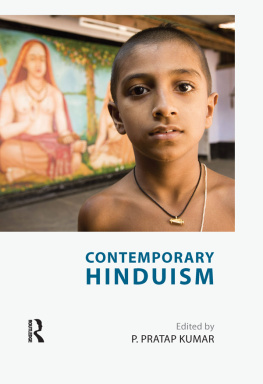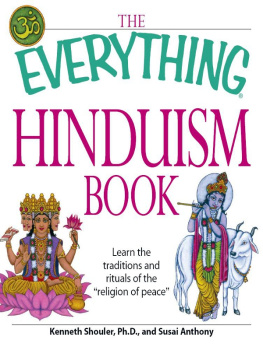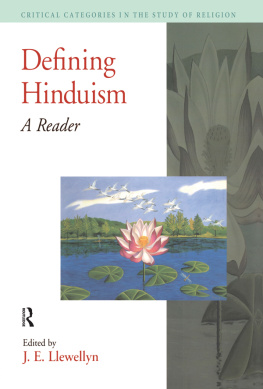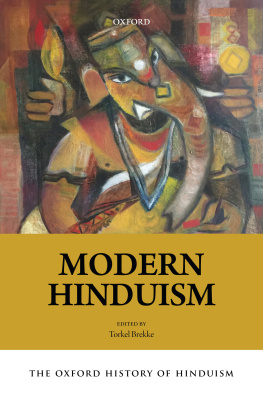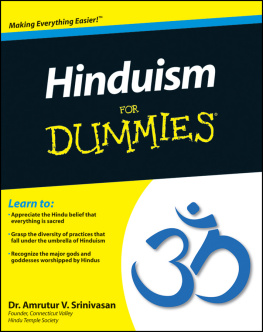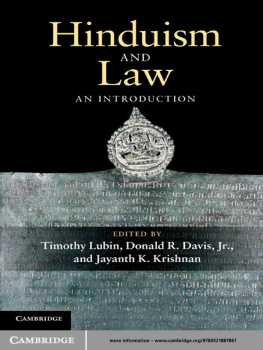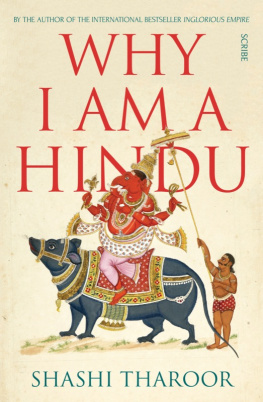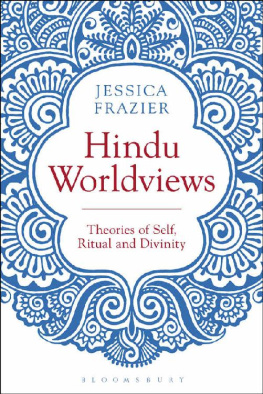CONTEMPORARY HINDUISM
Religions in Focus
Series Editor: Graham Harvey, Open University
The Religions in Focus series offers a radical new venture in the study of religions: textbooks that introduce religions as they are actually lived. Books in the series examine contemporary religious activities and communities and the varied ways in which texts and traditions are employed in the evolution of religions
First published 2013 by Acumen
Published 2014 by Routledge
2 Park Square, Milton Park, Abingdon, Oxon OX14 4RN
711 Third Avenue, New York, NY 10017, USA
Routledge is an imprint of the Taylor & Francis Group, an informa business
Editorial matter and selection, P. Pratap Kumar, 2013. Individual chapters, the contributors, 2013.
This book is copyright under the Berne Convention. No reproduction without permission.
No reproduction without permission.
All rights reserved. No part of this book may be reprinted or reproduced or utilised in any form or by any electronic, mechanical, or other means, now known or hereafter invented, including photocopying and recording, or in any information storage or retrieval system, without permission in writing from the publishers.
Notices
Practitioners and researchers must always rely on their own experience and knowledge in evaluating and using any information, methods, compounds, or experiments described herein. In using such information or methods they should be mindful of their own safety and the safety of others, including parties for whom they have a professional responsibility.
To the fullest extent of the law, neither the Publisher nor the authors, contributors, or editors, assume any liability for any injury and/or damage to persons or property as a matter of products liability, negligence or otherwise, or from any use or operation of any methods, products, instructions, or ideas contained in the material herein.
ISBN: 978-1-84465-689-9 (hardcover)
ISBN: 978-1-84465-690-5 (paperback)
British Library Cataloguing-in-Publication Data
A catalogue record for this book is available from the British Library.
Typeset in Gentium.
Contents
P. Pratap Kumar
Jeffery D. Long
Deepak Shimkhada
Paul Younger
Indrani Rampersad
Knut A. Jacobsen
Michael Baltutis
Antoinette E. DeNapoli
Steven W. Ramey
Hanna H. Kim
Shandip Saha
Jon Keune
Ramdas Lamb
Abhishek Ghosh
Amy L. Allocco
George Pati
Archana Venkatesan
Afsar Mohammad
William Harman
P. Pratap Kumar
As the editor of this book, I wish to first acknowledge the hard work put in by all the contributors in shaping their chapters and making them suitable for the readership intended for the Religions in Focus series. All chapters in this book have been thoroughly peer-reviewed by scholars in the field. I particularly wish to acknowledge the assistance of Jeffery D. Long for his painstaking review of many chapters. I also thank the publishers anonymous reviewers for their many helpful comments. This book could not have materialized without the help of Graham Harvey, who conceived the series and gave shape to this book as the first in the series. Obviously no book sees the light of day without the hard work of a group of experts in the publishers office, such as reviewers, copy-editors and a host of others. I wish to thank all of them, especially Tristan Palmer, my editor, for working closely with me. I have had great pleasure in working with all who have contributed to the final shape and content of Contemporary Hinduism, and I thank all of them and hope that this book will prove a real contribution to the understanding of Hinduism today.
P. Pratap Kumar
Every author in this book brought his or her own narrative style. As the editor, I have allowed such diversity of narrative style as it also makes the very point about the diversity of Hindu practice. However, some points need clarification. In presenting their narratives most authors limited themselves to a minimum of Sanskrit or regional vernacular words, but there are still a fairly large number of key non-English terms in use across the chapters. We have used the glossary section at the end of the book to provide brief definitions of most of these key terms in an easily accessible manner. The foreign words that appear in the glossary have been highlighted in bold at their first occurrence in the text. While Sanskrit words have been placed with diacritical characters to indicate correct pronunciation, some vernacular words have been left without diacritical characters as some scholars who used them anglicized such spellings. As the editor, however, I am satisfied that the foreign words are easily pronounceable by nonexpert readers with or without diacritical characters.
P. Pratap Kumar
Being a Hindu can be removing ones shoes before entering a temple; or offering worship to and Ayyappan devotees practice their respective traditions side by side and neither feels less Hindu; or seeing the deities in images of stone and metal and offering service to them can be a profound Hindu experience; or, for some Hindus, accessing their personal deity in the temple on a hill top can be as fulfilling as receiving deep intellectual knowledge of God; or in some cases Hindu ascetics can be militant political activists.
Any of the above, or a combination of the above, or all of the above could form authentic Hindu practice. With so many ways, Hindu practice is not always drawn from elite versions of texts, but from perpetually evolving regional traditions that are expressed in vernacular languages. It is this diversity that this book aspires to achieve. In dealing with contemporary Hinduism, the distinctions of great and little, classical and popular collapse and there is no need to privilege the textual tradition over the ordinary Hindu religiosity, as some scholars of Hinduism tended to do (e.g. Flood 1996: 67).
Not only within south Asia, but also in the diaspora context we find such vastly diverse Hindu practices. Hindus are today all over the world and have established their traditions in the many host countries in which they have chosen to reside. There is a plethora of Hindu traditions that are available in the diaspora today. Some have attained unique local versions of what they might have brought from the subcontinent; others are more recent plantations of present-day temple traditions in India. And these diaspora Hindu traditions have today become the first line of contact for many a modern person. At the same time, in the subcontinent of India, Hinduism has continued to evolve and diversify, exhibiting a variety of fascinating forms. The primary focus of this book, therefore, is the lived experience of Hindus spread not only across the subcontinent, but also throughout the world.
Introducing contemporary Hinduism is therefore about looking out for two aspects to carefully document what people do in their daily religious life; but also to locate those descriptions in the regional and vernacular narratives, and to desist from essentializing those descriptions in line with the idealized elite versions. For so long the study of Hinduism has focused on the idealized elite versions that are often construed as a monolithic, single and continuous narrative. Focusing on contemporary Hinduism fundamentally calls into question such presumed unity in Hinduism. It forces us to look at such a wide variety of traditions that are not necessarily tied to a single narrative drawn from the privileged textual sources. Besides, traditions that are so far flung from each other across India and the diaspora locations are sometimes marked by their differences more than their similarities. Attempting to force unity among them can only result in a lack of appreciation for the rich diversity in form, structure and content of those narratives. As C. J. Fuller (2004: 28) rightly says, it is mistaken to overstate the unity of Hinduism. Even when unifying factors are felt to be necessary for a common understanding of Hinduism, such unity need not be built on the basis of how popular traditions are related to the elite Brahmanical traditions, but rather the other way around is also possible. I shall discuss the methodological implications of such shifting of focus and attention in the Afterword. For now, let me not delay the reader from absorbing and appreciating the rich diversity of narratives that we have included in this book.
Next page
